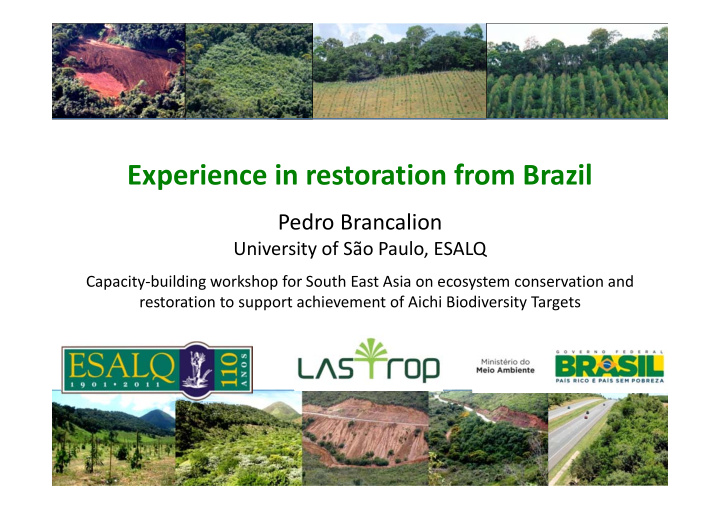



Experience in restoration from Brazil Pedro Brancalion University of São Paulo, ESALQ Capacity-building workshop for South East Asia on ecosystem conservation and restoration to support achievement of Aichi Biodiversity Targets
Structure Degradation and restoration in Brazil: an overview From deforestation to reforestation An integrated policy for ecological restoration Early lessons for tropical countries
Degradation and restoration in Brazil: an overview 85% 40% 50% 12% 50% All Brazilian economic cycles were directly linked to the destruction of its natural heritage
Degradation and restoration in Brazil: an overview • 1862: beggining of the reforestation of the Tijuca Forest leaded by Manoel Archer, by planting 127,000 seedlings in 13 years. • 1934, 1965, 2012: Brazilian Forest Code – establishes minimum forest cover in private landholdings (from 20 to 80%) and areas of permanent protection (conservation and restoration)
Degradation and restoration in Brazil: an overview Demand for restoration according to the new Forest Code 10 8 Millions ha 8 (Mha) 6 5 6 4 2 2 0 Total = 21 Mha Amazônia Mata Cerrado Caatinga Atlântica Pantanal Pampa
From deforestation to reforestation
2010 250,000km 2 of new protected areas and • 100,000km 2 of Indigenous Lands demarcated •
Área (10 3 km 2 /ano) 10 15 20 25 30 35 0 5 Área (10 3 km 2 /ano) 88* 21.05 10 15 20 25 30 35 0 5 89 17.77 88* 21.05 90 13.73 89 17.77 91 11.03 90 13.73 Deforestation in 2013: 5.843 km 2 92 13.786 91 11.03 93* 14.896 92 13.786 94* 14.896 93* 14.896 - 94* 14.896 95 29.059 Legal Amazon Deforestation Legal Amazon Deforestation 95 29.059 79 % 2004-13 96 18.161 + 28 % 2012-13 96 18.161 97 13.227 97 13.227 98 17.383 98 17.383 99 17.259 99 17.259 2000 18.226 2000 18.226 2001 18.165 2001 18.165 2002 21.651 2002 21.651 2003 25.396 2003 25.396 2004 27.772 2004 27.772 2005 19.014 2005 19.014 2006 14.286 2006 14.286 2007 11.651 2007 11.651 2008 12.911 2008 12.911 2009 7.464 2009 7.464 2010 7 2010 7 2011 6.418 2011 6.418 2012 4.571 2012 4.571 2013 5.843 2013 5.843
From deforestation to reforestation
From deforestation to reforestation Forest transition theory Pre 100 Early Late Post Forest cover (%) Environ. Policies 0 Time
From deforestation to reforestation Economic support for New tools for assessing legal environmentally friendly africulture compliance +
The Atlantic Forest Restoration Pact: A major effort by Brazilian society to restore and transform its most threatened biome Potential areas for forest restoration (ha) PR 2.455.537 RS 891.716 SC 1.402.183 MS 186.453 ES 1.043.374 MG 5.648.981 RJ 939.800 SP 2.077.885 AL 307.744 BA 2.104.512 Calmon et al ., 2011 PE 395.528 17.453.712 Σ Melo et al ., 2011
An integrated policy for ecological restoration Competition for land, leakag e Forests Elsewhere Old-growth stands are substituted by young- regenerating forests: losses in biodiversity and ecosystem services Pasturelands
An integrated policy for ecological restoration Reducing competition for land and sparing land for reforestation Latawiec AE, Strassburg BBN, Brancallion P, Rodrigues R., (submitted to Frontiers in Ecology and Environment
An integrated policy for ecological restoration • Current productivity : 118 million Animal Units; • Potential sustainable carrying capacity: 367 mi Animal Units; � Current productivity only 32-34% of potential All 2040 production targets + 36 Current Productivity Potential Productivity million hectares restored Restored Areas Strassburg, Latawiec et al. (submitted)
Restoration models that provide income
An integrated policy for ecological restoration Creating policies to foster restoration Land use Targeting areas Forest planning for restoration (leakage) cover increase Improving Reducing reforestation deforestation models
Early lessons for tropical countries Reforestation is only justifiable when deforestation in low Legal instruments and policies are needed Restoration has to be included in a land use planning context Restoration has to be included in a land use planning context Restoration has to become more attractive to farmers
Thank you pedrob@usp.br www.esalq.usp.br/lastrop
Recommend
More recommend